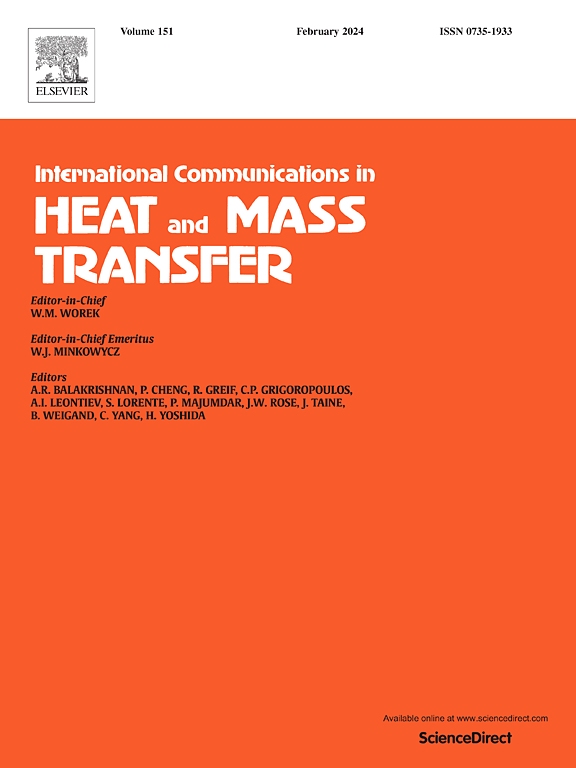Optimal designs of hybrid jet impingement microchannel heat sink across various pumping powers: A deep-learning approach
IF 6.4
2区 工程技术
Q1 MECHANICS
International Communications in Heat and Mass Transfer
Pub Date : 2025-03-27
DOI:10.1016/j.icheatmasstransfer.2025.108902
引用次数: 0
Abstract
Hybrid jet impingement/microchannel heat sinks (HJIMCHS) are an effective cooling technique for high heat flux electronics, providing efficient heat dissipation and enhanced temperature uniformity. To expand the applicability of HJIMCHS to a broader range of cooling challenges, it is crucial to optimize their heat transfer performance across a wide range of pumping powers (), rather than focusing on a single operating point. This study numerically solves the fluid flow and heat transfer characteristics of a silicon-based HJIMCHS with water as the coolant, and then the geometric variables of the HJIMCHS, including jet slot length (), jet slot and channel width (), jet slot height (), and the number of microchannels (N), are simultaneously optimized over a broad range of (). The optimization process employs the non-dominated sorting genetic algorithm II (NSGA-II), powered by a surrogate artificial neural network model, and objective functions are total thermal resistance (), maximum temperature difference on the bottom wall (), and entropy generation rate (). Optimal trade-offs between pumping power and the objective functions are explored by optimizing the HJIMCHS design at each pumping power. Results indicate that using as an objective function across all values may lead to inferior heat transfer performance, necessitating careful consideration. Additionally, with a heat flux of , for , the optimal compromise solution results in and , similarly for the results are and .
基于深度学习方法的混合射流冲击微通道散热器优化设计
混合射流冲击/微通道散热器(HJIMCHS)是一种有效的高热流密度电子设备冷却技术,提供高效的散热和增强的温度均匀性。为了将HJIMCHS的适用性扩展到更广泛的冷却挑战,在大范围的泵送功率(Π)中优化其传热性能至关重要,而不是专注于单个工作点。本文数值求解了以水为冷却剂的硅基HJIMCHS的流体流动和传热特性,并在Π (0.01W≤Π≤0.15W)范围内对HJIMCHS的射流槽长度(Ljet)、射流槽与通道宽度(Wjet)、射流槽高度(Hjet)、微通道数(N)等几何变量进行了同步优化。优化过程采用非支配排序遗传算法II (NSGA-II),以代理人工神经网络模型为动力,目标函数为总热阻(RT)、底壁最大温差(TD)和熵产率(Ṡgen)。通过优化HJIMCHS在各抽运功率下的设计,探索抽运功率与目标函数之间的最优权衡。结果表明,使用Ṡgen作为所有Π值的目标函数可能导致较差的传热性能,需要仔细考虑。另外,当热流密度为200W/cm2时,当Π=0.057W时,最优折衷方案的RT=0.0963K/W, TD=2.9°C;当Π=0.15W时,最优折衷方案的RT=0.079K/W, TD=2.3°C。
本文章由计算机程序翻译,如有差异,请以英文原文为准。
求助全文
约1分钟内获得全文
求助全文
来源期刊
CiteScore
11.00
自引率
10.00%
发文量
648
审稿时长
32 days
期刊介绍:
International Communications in Heat and Mass Transfer serves as a world forum for the rapid dissemination of new ideas, new measurement techniques, preliminary findings of ongoing investigations, discussions, and criticisms in the field of heat and mass transfer. Two types of manuscript will be considered for publication: communications (short reports of new work or discussions of work which has already been published) and summaries (abstracts of reports, theses or manuscripts which are too long for publication in full). Together with its companion publication, International Journal of Heat and Mass Transfer, with which it shares the same Board of Editors, this journal is read by research workers and engineers throughout the world.

 求助内容:
求助内容: 应助结果提醒方式:
应助结果提醒方式:


